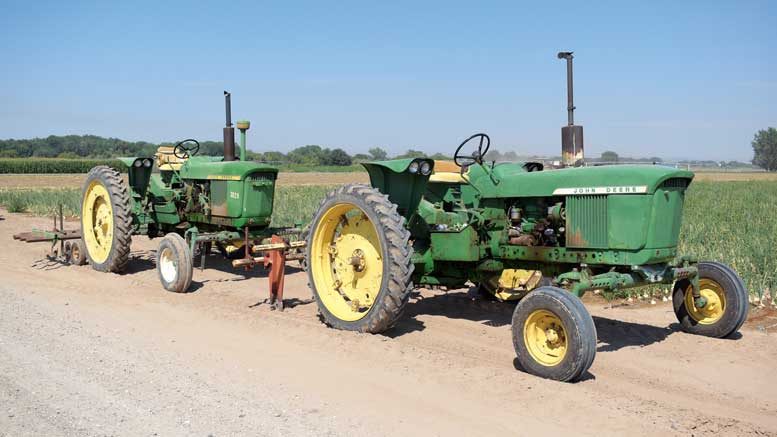|
Click to listen to this article
|
Story by Denise Keller, Editor
Photos by Dave Alexander, Publisher
A new marriage, a new baby and a new farm all within a few years. Add in the challenges of the pandemic and record-high farm input costs, and one might argue that if Conrad and Kody Williams can make it through all this, they’re in it for the long haul.
The Williams family farms 1,100 acres in Fruitland, Idaho, including 150 acres of Russet Burbank potatoes, with the remaining acreage in onions, corn, wheat and alfalfa. This year will be their fourth season farming on their own.
Growing up, Conrad had spent time on his family’s hay farm. After studying agriculture at the University of Idaho, he worked for other farmers for four years. Similarly, Kody had grown up on her family’s feedlot operation, studied agriculture at Washington State University and returned to the family farm in eastern Washington.
Ready to take the next step, Conrad began looking for an opportunity to farm row crops on his own. His grandfather suggested he talk to Dell Winegar, an onion and potato grower in Fruitland. Winegar was ready to retire but didn’t have anyone to take over his farm. The two came to an agreement for Williams to purchase Winegar’s farm and all the row crop equipment. Conrad relocated to Idaho in the fall of 2019 and worked alongside Winegar as he harvested his final crops.
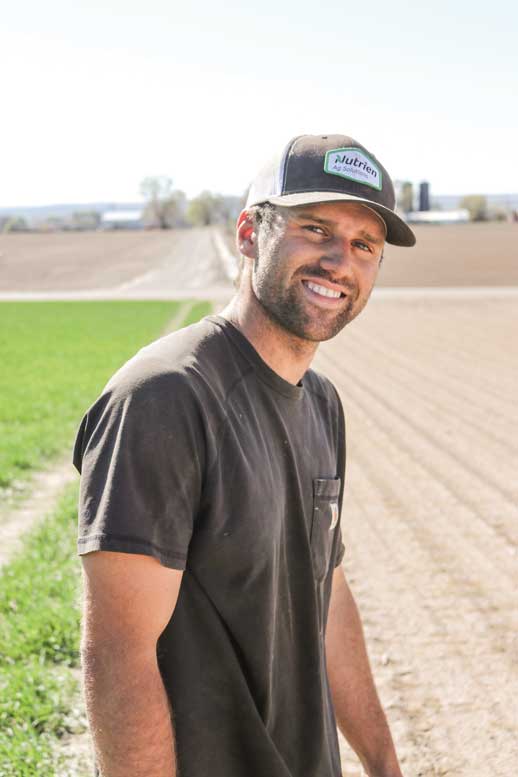
“There are not many people that want to get into farming. It’s really tough financially for small family farms to get started,” Conrad says. “Without the help of the Winegar family, we wouldn’t have been able to be raising row crops down here in Idaho just because of the cost of the equipment.”
In the spring of 2020, Conrad and Kody planted 300 acres, including 75 acres of potatoes. Winegar showed the young growers the ropes the first year, teaching them the nuances of farming that Idaho ground. They took over his contract with the processor and were able to farm the full 150 acres the second year.
“The farm’s growing faster than what I thought it would. Personally, I had a goal – I didn’t tell very many people – but I wanted to be farming 1,000 acres by the time I hit 30 years old, and I did it,” Conrad says.
He shares some of the credit for achieving his goal with Winegar, who helped him get started and continues to live across the road from the farm.
“He sits up on the hill and looks out his living room window and watches us young kids carry on his farm. I think he enjoys that,” Conrad says.
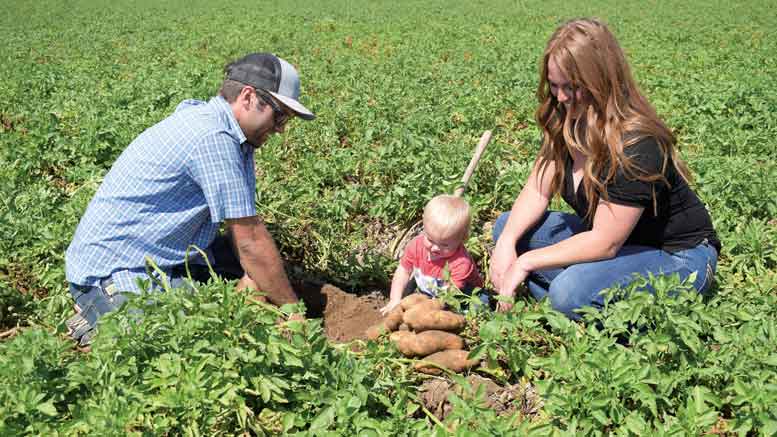
Growing Pains
Settling in on their new farm, the Williamses could see the property needed some upgrades. The aging irrigation system with hand lines and furrows demanded the most immediate attention. Since taking ownership, Conrad has made a lot of improvements, including putting in a dozen new center pivots, replacing the hand lines in most fields. He’s initiated the use of soil moisture monitors and improved irrigation scheduling, which has resulted in more consistent soil moisture levels and made a big difference in the crops.
The use of center pivot irrigation is less common in western Idaho than in the Columbia Basin of Washington, the grower says. Learning to farm spuds for other growers in the Columbia Basin helped him learn to work with the latest technology, taught him good farm management and agronomy practices and equipped him well to farm on his own in Idaho.
“It’s what you know, it’s what you’re around, and it’s what your farm can allow you to do. In farming, there’s a million different ways to do it, but everyone is trying to get to the same outcome. I don’t think there’s any right way to do it,” Conrad says.
Even with new irrigation equipment on the farm, the grower makes it a priority to check soil moisture levels often. He digs daily and babysits the crop as he continues to learn the best way to grow potatoes in the area and maximize the potential of the sandy soil on his farm located along the Snake River.
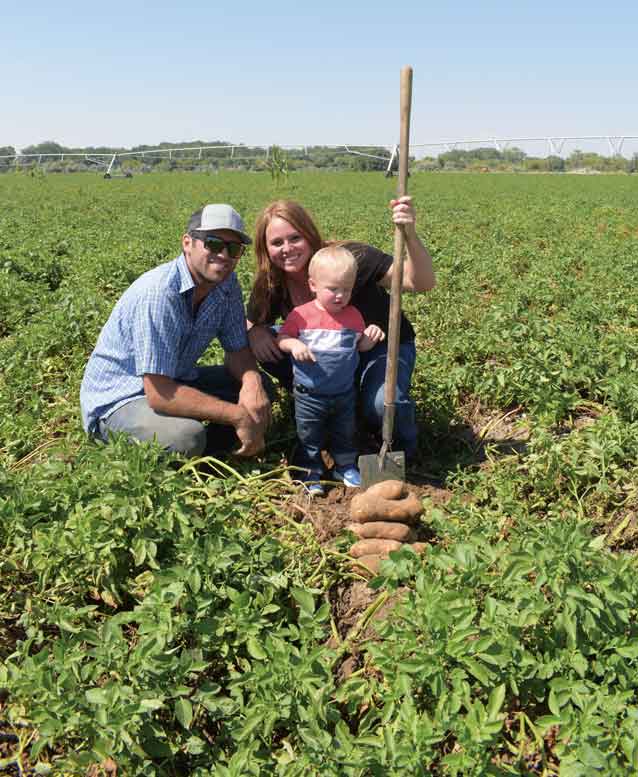
Along with the hiccups that come with being a new grower are the obstacles facing most growers, including a tight labor supply, extreme weather and rising input costs.
To contend with the lack of labor in the area, Williams Farms has been utilizing the H-2A guest worker program, which has been a game changer the last two years, according to the growers. Farm work throughout the season from planting to harvest has been completed on time with the help of the reliable labor.
“I think the key to farming is developing a program that works well for you, and timing is everything. So to have a crew of guys that we don’t have to worry about finding another job because they came here on a contract to work with us, they want to work, and they do a really nice job and everything just seems to flow, that’s been huge,” Kody says.
Through the program, Williams Farms hired two workers the first year and four the second year. They also invested in building worker housing on the farm last year.
“I don’t think I could farm long term if I couldn’t do the H-2A program because there’s just no one around here who wants to work,” Conrad adds.
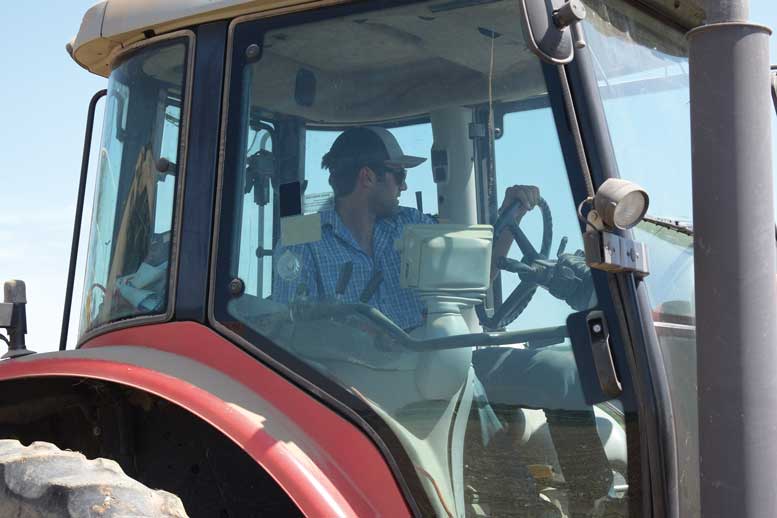
A Young Family Farm
Despite the challenges faced in farming, Conrad and Kody are living their dream. Conrad loves the freedom of setting his own schedule and enjoys time in the fields. Kody never imagined living anywhere other than a farm.
“There’s a lot of risk. It’s a lot of hours. I think a lot of people are scared of the hours. But if you want to farm, it’s in your blood and you just have to do it. You just have to go and you can’t stop,” Conrad says.
“You have to have a deep passion for this field for it to work,” Kody agrees. “Raising my kid on a farm, I don’t think there’s any better place to grow up. I think we truly enjoy getting to work outside, getting to grow a crop for people that sometimes maybe they don’t even recognize how much work went into it, and then going into the grocery store and seeing potatoes. I love that.”
The growers would like to eventually increase production to 1,800 to 2,000 acres and hope to increase potato acreage as part of that growth. They would also like to see more young people pursue farming, but recognize the difficulty in getting started. In fact, given the rising number of corporate farms in the industry, they fear that few family farms will remain. They believe keys to longevity will be to find a niche or specialized market for their products and to work hard to consistently produce high quality crops.
“The farmers that grow good onions or good potatoes every year and are consistent and work hard to make sure they do that every year are the ones that last a long time,” Kody says.

